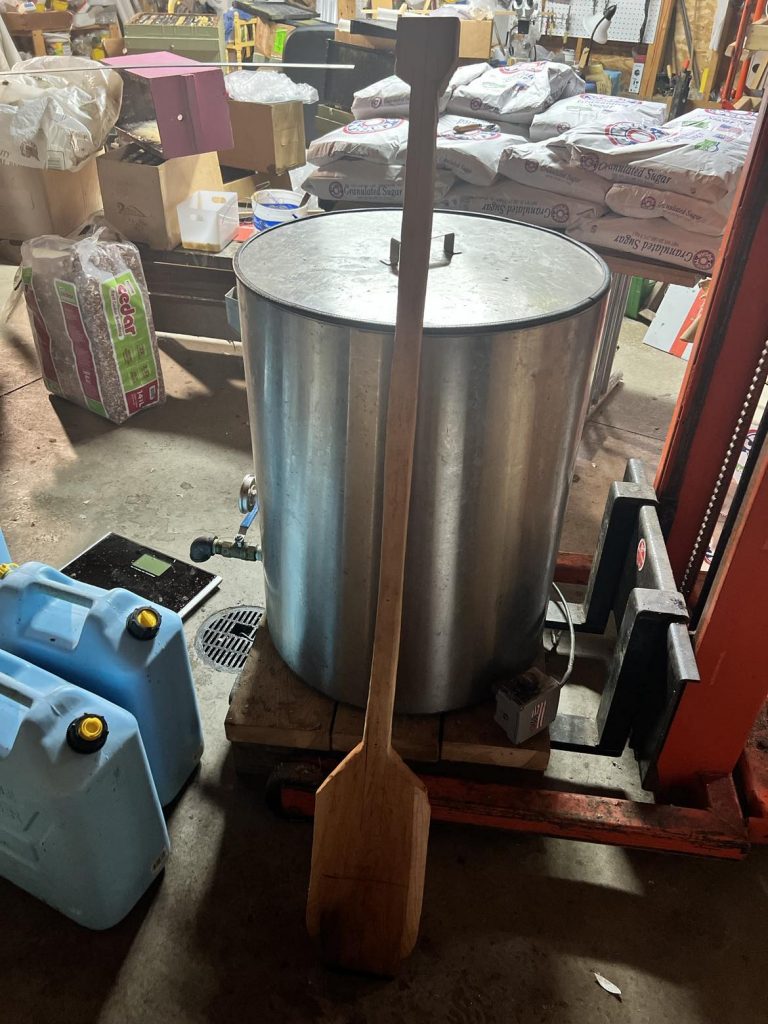I can’t get out of Costco without someone remarking on the amount of sugar I’ve bought, even my wife. “Is that enough?” she said (with a little sarcasm) the last time we were there. So, just because, I threw two more 25-pound bags on the cart. This fall I’ve been there three times, whereas last year I was only there once. I like throwing the 25- and 50-pound bags around. In 1984 I moved from an accounting office to an adhesives factory, and we threw 25 kilo bags of materials into adhesive and sealant mixers. I enjoyed the exercise and the work. I wasn’t suited to accounting.
The season is changing from summer to fall and because of the drought the Goldenrod didn’t produce any nectar – this year that distinctive sweaty sock smell was absent. The asters are flowering, but in my part of Wisconsin they’re stunted. It’s late September and there was a little nectar coming in yesterday, but not enough to add weight to the colonies.
Years ago I bought two old Maxant 40 gallon stainless steel heated bottling tanks from a candle factory, refurbished them, and I use one to mix syrup. The other sits idle. I load 175 pounds of sugar into the tank and 90 pounds or so of water and mix it up with a maple paddle I carved. This gives me about 24 gallons of syrup.
Another Craigslist bargain was my hydraulic forklift. I use this to raise the Maxant tank and let the syrup out into 5 gallon water jugs that are sitting on a bathroom scale. I fill the jug to about 45-50 pounds. I could fill to 50-55 pounds or so, but my body has degraded since 1984. When I first started feeding nucs I bought a bunch of ½ gallon mason jars, and they worked quite well, but I hate washing them at the end of the season. My feeder washing is done outside in the shed, and invariably I’ll drop a mason jar and shards of glass will fly everywhere. This year I only used two mason jars, for the rest of my feeding I used cap and ladder frame feeders set above the colony. They don’t shatter when you drop them. I put a piece of reflectix on top of the frames and leave a gap at the back of the nuc colonies, then set a box holding one or two feeders on top of that. The bees enter from the gap, run up and take down the syrup.

Two of my friends have changed over and are feeding high fructose corn syrup (HFCS), bought by the tote from larger beekeepers. The price is about the same as sugar syrup, but they don’t have to mix it. I remembered that there is a possibility of having one’s HFCS degrade by heat and produce 5-hydroxymethyl-2-furaldehyde which is more commonly abbreviated to HMF. It’s bad for bees, and a beekeeper can’t easily tell that its present. Just a moment ago I forwarded the Bee Culture article that explained it’s deleterious effects to my friends–there’s nothing like receiving scientific evidence that you might be hurting your bees before seven in the morning on a weekend. That’s what friends are for. I’ll keep sticking to the sugar, not because I am particularly worried about HMF, but because I feel manly and young as I throw the bags of sugar around.
Another part of winter preparation is the right-sizing assessment. In August when I boost the understaffed nucs that I started from cells (made in July around the appropriately named independence holiday) I add drawn frames of brood and honey from the overstaffed production colonies that have gone through my Biotechnical varroa mite control process. I do this because the newly developing colonies won’t have enough time to grow large enough to draw out the frames themselves. This past June my first graft of the year resulted in more colonies than I needed for production, and I ended up with about six that had grown and filled out a five-over-five colony. In previous years I have sometimes forgotten about these spare colonies and then they have swarmed. I hate dealing with swarms. When I saw that they were starting to beard excessively in July I added a third level of 5 frames, taking two frames from the second box and replacing them with two undrawn frames, and then moving those two drawn (d) frames into a third box with and accompanying three undrawn (u) frames. Left to right the top box was arranged dduuu, and the box below it uuddd. They didn’t swarm, but they didn’t draw out the frames very much either. This was unfortunate because I had plans for these frames.
There are two colonies that remain understaffed, and underfed and are each housed in a 5-frame box. I didn’t boost them in August because I didn’t have enough frames in that particular apiary. I have brought them home and yesterday I was planning to reduce some 5/5/5’s to 5/5’s and use those extra frames but that wasn’t possible. I reduced the 5/5/5’s to 5/5’s, but didn’t harvest drawn frames to boost those small colonies. I am still mulling over what to do with them. I have a few colonies in traditional 10 over 10, or 10 over 10 over 10 deep frames, but I am reluctant to break them down because I am only confident that the frames in the top boxes in those colonies are completely drawn out. It’s a cardinal sin to attempt to winter bees in a colony in which the top box is incompletely drawn out.
I may consider resurrecting the Styrofoam Bee(r) Coolers and winter them in 6 frames, but that requires some work. I have some filled honey frames in a fridge in my shed, but I don’t think there’s enough. Slowly, but surely the season is winding down. I had better get my act together. Winter will be here soon.
If you like Adrian’s writing be sure to check out his book “The Cavity Compromise” available on Amazon, Barnes and Noble, and other booksellers. For a signed copy send a check made out to Adrian Quiney, 802 Badlands Road, Hudson, WI 54016; Please note if it needs to be sent to an address different from the address on the check or return mailing label.
